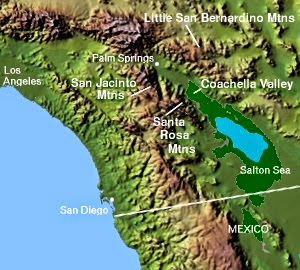Along with the
wonderful weather and beach, San Diego's physical geography is different than
many other places. Due to colliding tectonic plates, San Diego experiences many
earthquakes and mountains, some unlike any other.
 |
| Southern California is the only place that has two tectonic plates going against each other. |
One of San Diego's
unique geography is its tectonic plates. Southern California lies on the
Pacific tectonic plate, which is different than much of the United States. But,
even though Southern San Diego lies on the Pacific plate, other parts of
California lie on the Northern plate. California having two different tectonic
plates creates a sliding boundary. This sliding boundary is caused because of
the San Andreas Fault, This has made a split in California and has caused the
two tectonic plates to slowly grind against eachother and slide past each other
a little every year. This fault also causes many minor earthquakes and half of
the major earthquakes to happen in the region. Along with earthquakes,
sinkholes and landslides also occur because of the tectonic plates clashing
against each other.
 |
| This landslide occured in Laguna Beach and destroyed up to 11 homes. |
San Diego in 10,000 years, 1,000,000 years, and 100,000,000 years in the future
There is a big hypothesis that in the future California will
experience a major earthquake and will break off and sink under water but, that
is not true. The only way this could happen is if the earthquake had a
magnitude of 10.5 and the San Andreas was ten times longer than the 800 miles
it is. But, I believe having two plates sliding past each other little by
little every year will in future cause a change in the geographic location and
shape of the state of California. The San Andreas Fault, has already split
California into two, in a sense, with the North American plate sliding down and
the Pacific Plate sliding up, Because of the plates clashing and grinding
together, many earthquakes erupt throughout the region, that sometimes cause
landslides. It is said that with every year the rate of slippage with the
plates are an average of 1.4 inches. Therefore if this rate of slippage was to
continue in the same pace, in 10,000 years the slippage would have resulted in
14,000 inches between the two tectonic plates. In 1,000,000 years, the rate of
slippage will result in 1,400,000 inches. Lastly, in 100,000,000 years, if the
rate of slippage continues at 1.4 inches every year, then it will be 2,209
miles of slippage that happened. At this point it will be view-able by the
normal eye the change of the geographic location of California. Therefore, the
idea that California will break off due to some earthquake and sink, is not
true. However, instead of breaking off due to an earthquake, California can
split and drift away from the US because of the tectonic plates grinding in
different directions. As a result, California may drift far enough to be
underwater, but to see it drift underwater is something that could happen in
100,000,000 and plus years.
The geography of San Diego
will continue to change in time because of nature/ human made changes. However,
with the world evolving the future can change in a positive or negative way,
meaning what we predict today can be wrong in the future.
References
Oskin, By Becky. "What Is The San Andreas Fault?" LiveScience. TechMedia Network, 01 May 2014. Web. 07 Dec. 2014.
"Earthquake Facts & Earthquake Fantasy." Earthquake Facts & Earthquake Fantasy. USGS, 29 Sept. 2014. Web. 07 Dec. 2014.





.jpg)







.jpg)

.jpg)